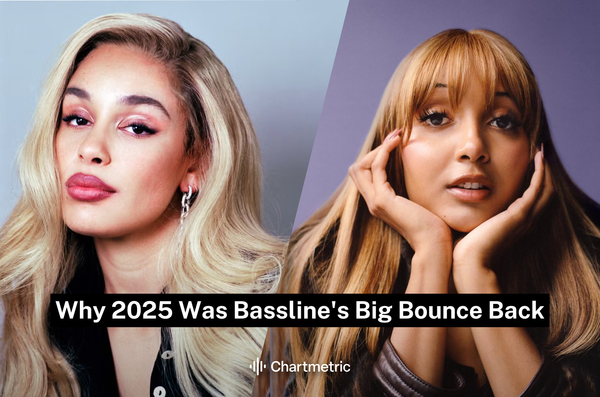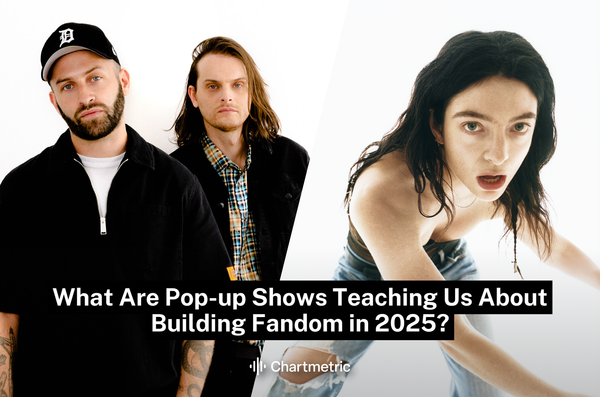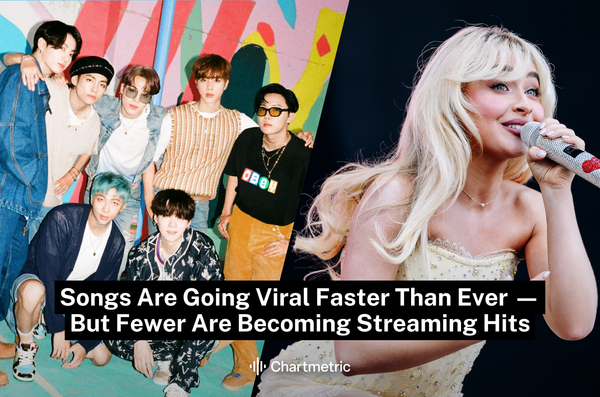From viral TikTok tracks to bite-sized Grammy-winning singles, it appears that popular music is getting shorter than ever. As drawn from Chartmetric’s own 2024 Year in Music Report, the average Spotify charting song was around 3 minutes long—nearly 15 seconds shorter than in 2023 and 30 seconds shorter than in 2019.

We are also seeing more short-song outliers than in previous decades. A standout example is Lil Yachty’s 83-second hit “Poland” in 2022, which reached Number 40 on the Billboard Hot 100 and currently has nearly 154 million streams. At the 2024 Grammys, nearly 20% of songs clocked in under three minutes. At the 2025 Grammys, two songs that were nominated for Record of the Year, Sabrina Carpenter’s “Espresso” and Charli xcx’s “360,” were similarly short.
It may be tempting to blame shrinking song lengths on the short attention spans of listeners in the streaming age. But music journalist, NYU music professor, and co-host of the podcast Switched on Pop, Charlie Harding, believes there are more factors at play than one might expect. “This trend is multi-variant, with lots of influences,” he told Chartmetric. “It’s not just technology, it’s not just culture.”
AABA Form and 78s
Historically, song length has been most observably affected by changes in songwriting trends and listening technology. Trends in the early-to-mid 20th century prove that short songs are nothing new. In those years the AABA song structure dominated, with the average song lasting around two minutes and 30 seconds. This was in part due to the limitations of 78 rpm records. In popular use between the 1900s to 1940s, 78s maintained maximum sound quality for only three to five minutes per side.
The 1961 hit “Blue Moon” by doo-wop group The Marcels can be distinguished as a quintessential AABA song. At two minutes and 15 seconds, it consists of the classic 32 bars, with two repeating strophes—the older version of a verse—signified by AA, followed by a contrasting bridge (B), and a final repetition of the strophe (A).
The AABA era demonstrates that the short song trend has long-standing roots. In fact, the shortest song to ever win Record of the Year at the Grammys was Henry Mancini’s “Days of Wine and Roses” in 1963, a song which lasted just two minutes and five seconds.
Verse-Chorus Form
The 50s and 60s saw the rise of the verse-chorus form, a trend that enabled more complexity in narrative. “One of the challenges of the AABA song form is that it’s harder to tell a story. There’s not much room,” described Harding. “So the verse-chorus song form starts to tell stories in creative and revolutionary ways.”
Verse-chorus form traditionally follows an ABAB pattern, in which the verse (A) advances the song’s main storyline, while the chorus (B) provides the song’s hook and emotional core.
Due to technological limitations on vinyl, songs remained on the shorter end until the advent of cassette tapes and CDs. The 12-inch long-playing (LP) record could hold about 22 minutes of music per side. Even so, during this time the growing popularity of the verse-chorus format began to creep song length slowly forward. As that format expanded, songs became even longer. At three minutes and 25 seconds, 1975’s Billboard hit "Love Will Keep Us Together" by Captain & Tennille is an example of a modified verse-chorus form, also featuring a bridge and refrain integration in the chorus, which further lengthens the song.
Song Lengths Historically and Today
Over the last 100 years or so, popular song length has essentially progressed through three major eras of change, as demonstrated in this chart of Billboard’s top songs of the year by decade, from 1925 to 2024.
The most drastic shift in song length of top Billboard singles in the included years is evident in 1985, when “Careless Whisper” by WHAM!’s George Michael led in the charts at a whopping six minutes and 30 seconds, topping the previous year’s chart leader by over three minutes. Notably, the CD was invented in 1979, and 1982 was the first year that CDs became commercially available, expanding the capacity of the standard listening medium to up to 74 minutes of music. Into the 90’s, CD capacity continued to make extended song length increasingly possible—over the course of the decade, average song duration increased to four minutes and 14 seconds.
Differences in song length can also be largely attributed to differences in song structure based on genre. Ambient tracks and ballads, for example, lend themselves to longer forms, whereas hip-hop and pop songs are shorter in nature. When it comes to popular genres in recent years, however, it appears that the five top genres of pop, hip-hop, alternative, dance, and Latin music all are getting progressively shorter on average.
Between 2018 and 2024, all songs decreased by at least 17 seconds. The greatest differences were in hip-hop and Latin music, with both genres seeing a decrease in average length by 29 seconds. Also of note, hip-hop emerged as at the top listened to genre in the charts five years in a row, bookended only by pop in 2018 and 2024.
Influence of Hip-Hop and the Digital Age
Hip-hop has been profoundly influential on modern music since its inception in the 1970s, including on trends in song length. As the digital age starting in the 80s transitioned listening technology from CDs to MP3s and eventually to streaming, hip-hop continued to experiment with different styles and forms, taking new liberties in songwriting technique and style.
“We’re going through another formal shift right now, going all the way back to the birth of hip-hop,” describes Harding. “Hip-hop songs have always been of varying length… however long [it takes to] say the thing you need to say.”
As hip-hop became more influential, artists across genres also began to adapt rap flow and song structures into their writing. “You don’t get Ed Sheeran without hip-hop, because the way that he sings has a hip-hop cadence,” Harding points out.
Ed Sheeran’s pop-rap track “You Need Me, I Don’t Need You” is a more obvious example of how hip-hop has shaped his style over the years. Even in mainstream hits like “Shape of You,” however, you can detect a subtle hip-hop influence in his vocal delivery and rhythm.
The accessibility of the streaming era and hip-hop’s popularity were also likely contributors to the rise of hook-based songwriting—or songwriting designed to catch the listener’s ear in the first few seconds. The increase in hook-based songwriting was also driven by the evolution of production technology, as making high quality music became possible in a home environment.
“Previously you would have to [write and record] the song separately, because studio time was expensive,” says Harding. “But now, writing and recording happen at the same time. People sit down in front of their software and write a loop, then sing multiple melodies over that loop, hunting for the best melodies.”
Harding gives the example of “BIRDS OF A FEATHER” by Billie Eilish as a profoundly hook-driven song. Since its release last year it became the third most streamed song of all time on Spotify, as well as the fastest song ever to surpass 2 billion streams. Length-wise, it is tied for fifth-shortest when compared against the remaining top songs of 2024.
“[“BIRDS OF A FEATHER” has] the simplest chord progression that [Eilish] has ever written, and yet structurally, it’s very unusual,” describes Harding. “She [combines sections] together to have them lay on top of each other later on.”
Artists are now being pushed to focus more than ever on crafting compelling melodies and storylines in a way that optimizes initial impact, likely in part due to revenue incentives—Spotify counts 30 seconds of listening as a full play that triggers a royalty payout.
While it is tempting to assign meaning to a pattern of decline in song length, Harding says it may be wise to not put too much stake in any one rationale in particular, both due to the slew of potential influences and for the music’s sake itself. He maintains that both quality and style should come far before considerations of length. “If we were to say “Blue Moon” is only a product of the phonograph era, that’s so demeaning to the value of that song.”
Can Writing Shorter Songs Actually Make You More Money?
“If you are already a huge star, perhaps one could say that,” says Harding per the above. “If you write 40 songs that are two minutes long, it’s possible [people will listen more frequently] because it takes up less time.”
At the same time, there are many examples of highly successful songs that are greater in length, and do not strictly follow the hook-based formula. Take The Weeknd’s “Blinding Lights.” It’s the most streamed song on Spotify of all time at 4.75 billion streams, but it starts with an almost 30-second intro. Compared to “Blinding Lights,” “Uptown Funk” by Mark Ronson and Bruno Mars comes in more quickly with a hook, but is 40 seconds longer than the 2014 average—the year the song came out—totaling about four minutes and 30 seconds. Even so, it has been steadily gaining streams ever since its release, now totalling over 46.5 million.
Ultimately, the most important factor in keeping listeners engaged is not song length, but quality. Instead of dictating creative direction, the duration of a song or album should serve the music itself. “Some songs need to be long,” Harding points out. “I’m sure there are managers that have really strong feelings [about shorter songs’ replay value], but if an album is boring, people won’t listen to the whole thing anyway.” While artists may want to consider length in terms of where their music will be played—such as in creating a club mix or a radio edit—quality remains paramount.
Looking ahead, Harding sees potential for a counter-trend. He notes that fatigue from the prevalence of short-form content could lead to the resurgence of phenomena like jam bands, such as Phish or Grateful Dead. “People want to go out and have social experiences,” says Harding. “They want long, dissociative music that takes them on a journey.” Whether the short song trend continues or not, one thing is for certain: engagement does not come from duration, but rather from creating compelling music that stays true to the artist’s vision.






